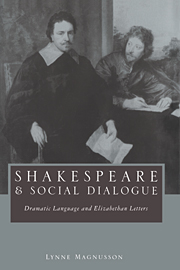Book contents
- Frontmatter
- Contents
- Acknowledgments
- Introduction
- Part 1 THE RHETORIC OF POLITENESS
- Part II ELOQUENT RELATIONS IN LETTERS
- Chapter 3 Scripting social relations in Erasmus and Day
- Chapter 4 Reading courtly and administrative letters
- Chapter 5 Linguistic stratification, merchant discourse, and social change
- Part III A PROSAICS OF CONVERSATION
- Notes
- Bibliography
- Index
Chapter 3 - Scripting social relations in Erasmus and Day
Published online by Cambridge University Press: 22 September 2009
- Frontmatter
- Contents
- Acknowledgments
- Introduction
- Part 1 THE RHETORIC OF POLITENESS
- Part II ELOQUENT RELATIONS IN LETTERS
- Chapter 3 Scripting social relations in Erasmus and Day
- Chapter 4 Reading courtly and administrative letters
- Chapter 5 Linguistic stratification, merchant discourse, and social change
- Part III A PROSAICS OF CONVERSATION
- Notes
- Bibliography
- Index
Summary
In the preceding chapters, I have proposed a modern rhetoric derived from discourse pragmatics as a heuristic tool for reading social exchange and interaction styles in letters, plays, and sonnets. Elizabethan letter-writers and others interested in the protocols of written exchange had several contemporary epistolary manuals available to instruct them, including Erasmus's “On the Writing of Letters” (De conscribendis epistolis – 1522), William Fulwood's The Enimie of Idlenesse (1568), Angel Day's The English Secretary (1586; part II, 1592), and John Browne's The Marchants Avizo (1590). Focusing on Erasmus and Day, this chapter examines how these sixteenth-century rhetorics map out, script, and play a significant role in the dissemination of both typical and novel social interactions. Denouncingthe existing hierarchical arrangement of human relations, Erasmus provides models and instruction in how to perform horizontal relations of reciprocal friendship; these alternative scripts fashion homosocial relations as he wishes them to be – and, at least to some extent, as he succeeds in determining them – among communities of learned men, or between boys and their tutors. At variance with the idealistic Erasmus in relishing both the eloquent cultural “poetry” that gives discursive shape to hierarchic relations and the space of opportunity that polite exchanges can open up for ambition, performance, and advancement, Day scripts elaborate discursive models for enacting vertical as well as horizontal relations.
- Type
- Chapter
- Information
- Shakespeare and Social DialogueDramatic Language and Elizabethan Letters, pp. 61 - 90Publisher: Cambridge University PressPrint publication year: 1999



